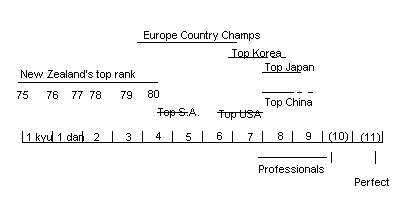 |
| Home | The NZGS | About Go | NZ Go Rules | Book Shop | Clubs and Contacts | Newsletter | History | Members | E-mail |
|
Shifting the goalposts |
|
In a previous Kamikaze kolumn we discussed the relative ranks used in the world and where New Zealand fitted in. The discussion was summarised in the diagram. We can see that the strongest New Zealanders in 1980 were 4-dan. In the years past there has been some improvement in the standard here yet the strongest players are still called 4-dan. I would like to have a look at this.
There is no world standard ranking system in go. This problem is shared with chess but is less defensible with go as handicapping makes it easy to compare ranks. It is more complicated in go with different systems for professionals and amateurs using the same names. Question 1: How do professional ranks compare over time? One old English language go book says that professional ranks should get tougher with time as the incumbents seek to elevate their own status. This seems not to be true. In 18th century Japan the only way to get promoted to 9-dan was to be superior to all other go players. Now there are more than 50 9-dans in Japan, and about 10 in each of Korea and China. The strength of the top players varies so a more reliable indicator of inflation would be the 10th strongest player; currently 9-dan, but in the 18th century probably less than 5-dan. Question 2: How do amateur ranks compare? Amateur ranks in Japan have become even more inflated. The highest an amateur can officially achieve in Japan is 7-dan and there are a few of these, about professional 4-dan in strength. However they can give 4 or 5 stones to some people that have officially been granted 5-dan ranks. Unofficial ranks are even worse. This means that a Japanese amateur rank is unreliable. Chinese and Korean amateur ranks are much more conservative. In China there is 1 amateur 7-dan and to get promoted to 5-dan you must be able to play a 9-dan professional on 3-4 stones. Initially we used comparisons to Japanese ranks when making promotions, but more recently we have tried to compare ourselves to European ranks. European ranks have been deflating over the last decade due to the influence of the Netherlands Go Association. Generally now professional strength players like Ronald Schlemper, Guo Juan, Shen Guangji etc are considered 6-dan, along with a few others who are just below professional level. This means that to get promoted to 5-dan in Europe you have to be able to play weaker professionals on 1-2 stones; a standard similar to China or Korea. Question 3: What has been happening to the level of New Zealand go? In 1980 the strongest New Zealand players were promoted to 4-dan but they had never beaten any professionals on 4 stones (I am ready to be proved wrong here). It is probably fair to say that they would have had to have 6 stones to play a 9-dan. Perhaps they were similar to a current Chinese or European 2-dan. Since then the best results of NZ players have been wins with 2 stones against shodan or 3 stones against 5-dan professionals. (These less than 50% of the time.) This puts us fairly and squarely in the 4-dan range in Europe or China. Question 4: Why do we do so well against Australia? Australian ranks are of a similar level to Japanese clubs. Generally Australian ranks are about 1 stone or more inflated relative to European or Chinese ranks. With some luck our 4-dans are a match for their 6-dans. Summary: Since 1980 the top level of New Zealand go players has increased by about 2 stones. This hasnít been recognised as a promotion due to our stiffer standards. A promotion to 5-dan would be justified by:
|
